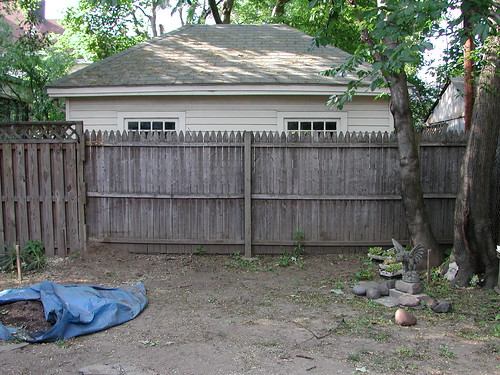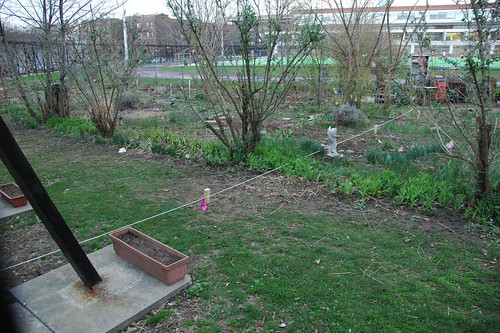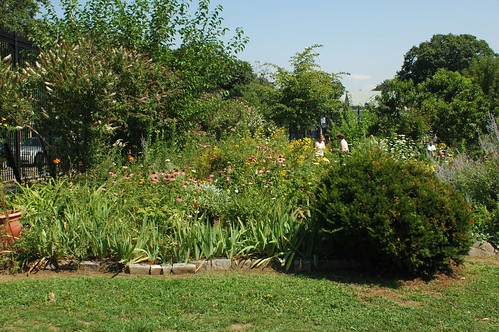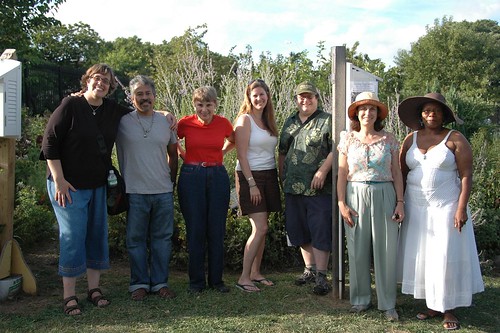As one of the first public gardens to use the internet to connect with its constituents, Brooklyn Botanic Garden has been online since 1995. Over the years, our site has grown to thousands of pages of content. As the size of the site grew, its architecture made much of this valuable information increasingly difficult for staff to keep up-to-date and for visitors to navigate.
We have now moved the site into a robust content management system, built using Expression Engine. We hope you enjoy our new format!
Look for new features including:
* Drop down navigation menus
* Related content in page sidebars
* More photos and clean page layout
* An improved Events Calendar
* Opportunity to comment on select pagesIf you have feedback on our new site, contact webmaster@bbg.org.
out the new
– About the New Website
Tag Archives: News
The Plight of NYC’s Native Flora
Local ecotypes – propagated from local sources by the Staten Island Greenbelt – for sale by Oak Grove Farms (now Nature’s Healing Farm) at the Union Square Greenmarket during the first annual NYC Wildflower Week in 2008. I bought one of each; two years later, all are thriving in my backyard native plant garden.
Earlier this week, the Brooklyn Botanic Garden issued a press release summarizing findings from 20 years of research through their New York Metropolitan Flora Project (NYMF). The results are not surprising, but disheartening nevertheless:
At least 50 varieties of native plants are locally extinct or nearing elimination, say project scientists. Nuttall’s mudflower (Micranthemum micranthemoides), last collected from the region in 1918, is likely extinct throughout its former range. Scarlet Indian paintbrush (Castilleja coccinea), pennywort (Obolaria virginica), sidebells wintergreen (Orthilia secunda), and sundial lupine (Lupinus perennis) are among the wildflower species to have seriously declined in the region. Black crowberry (Empetrum nigrum) is locally extinct, without a trace of a population remaining today in the New York City metropolitan area.
– Some Plants Native to NYC Area Have Become Locally Extinct As New Flora Has Moved In, Finds Brooklyn Botanic Garden, Press Release, 2010-04-05
The story has been widely covered in blogs and other media, including New York Times Science. I’ve included the complete press release below for reference.
I first wrote about NYMF in June of 2006, shortly after I launched this blog, four years ago next month. I’ve written about native plants countless times (see: Native Plant Profiles, Natives). I have a lifelong interest in the nature around me, especially that which is right around me, where I live. Learning about and understanding the ecosystems where I live is part of finding my place in the world. I come to feel this connection deeply. Without it, my life is impoverished, and I am lost.
The greatest threat to native plants, and the ecosystems they support, is habitat loss. The second is competition and displacement, and further habitat loss, from invasive species, whether they be insects, infectious organisms, or other plants. Roughly half of invasive plant species were deliberately introduced, through agriculture, for civil engineering purposes such as erosion control, and for horticultural purposes.
Some plants native to the region, like Britton’s violet (Viola brittoniana), are now rare in their natural habitats but thrive when brought into cultivation in the metropolitan area. Some non-native cultivated plants, such as Japanese barberry (Berberis thunbergii), can escape from cultivated landscapes and overrun natural areas, where they thrive and spread, crowding out more fragile plants.
Choices we make as gardeners affect the future of regional and local biodiversity. I’ve chosen to gradually transform the dust bowl that was our backyard when we moved into our home in the Spring of 2005:
into a native plant garden:
I’ve been rewarded with visits from dozens of other natives: bees and other pollinators, birds, even raccoons and opposums. (I still long for some native reptiles!) Although our local biodiversity is threatened, it is far from lost. If only we create a home for it, it can still find us.
The place name “Flatbush” originates with the old Dutch “vlacke bos”: the wooded plain. As I continue the transformation of this garden – this guided succession from dusty, barren wasteland to a small patch of forest – I am reconnecting with the genius loci, the spirit of the place. In this process, my spirit also finds a place, a home, in the woods I recreate.
Press Release
Brooklyn, NY — Brooklyn Botanic Garden (BBG) announces findings from the most comprehensive study of plant biodiversity ever undertaken in the metropolitan New York area.
New York Metropolitan Flora Project (NYMF) data, gathered over the course of the last 20 years, provide the first hard evidence of how native species are faring—and how non-native species are spreading—in counties within a 50-mile radius of New York City. The area of study includes all of Long Island, southeastern New York State, northern New Jersey, and Fairfield County, Connecticut.
While much of the botanical science community concentrates on researching and tracking the threats to biodiversity in the tropics, scientists at BBG have chosen to undertake an unprecedented study of their own region.
At least 50 varieties of native plants are locally extinct or nearing elimination, say project scientists. Nuttall’s mudflower (Micranthemum micranthemoides), last collected from the region in 1918, is likely extinct throughout its former range. Scarlet Indian paintbrush (Castilleja coccinea), pennywort (Obolaria virginica), sidebells wintergreen (Orthilia secunda), and sundial lupine (Lupinus perennis) are among the wildflower species to have seriously declined in the region. Black crowberry (Empetrum nigrum) is locally extinct, without a trace of a population remaining today in the New York City metropolitan area.
“In many areas, the snapshot this report provides is startlingly different from the printed maps, plant manuals, and landscape shots of just 40 years ago,” says Dr. Gerry Moore, director of Science at Brooklyn Botanic Garden and coordinator of the New York Metropolitan Flora Project. “A number of invasive species introduced from distant areas that have climates similar to ours—such as parts of Asia, Europe, and the southeastern United States—are newly thriving in the New York City area. For example, camphor weed, native to the southern United States, is common in Brooklyn now; however, at the time of the Garden’s founding a century ago, it was considered to be quite rare.”
Offering a precise map of as many as 3,000 plant species, the NYMF project findings are vital reference points for those involved in environmental efforts like conserving rare plants, planning parks and greenways, repairing degraded habitats, and designing home gardens.
Although agencies and municipalities may wish to restore native species to particular habitats, the NYMF findings suggest that some native species can no longer survive in their native region. “How do you, say, restore the flora original to a coastline, when you know that the sea level is rising each year?” asks Dr. Moore.
Some plants native to the region, like Britton’s violet (Viola brittoniana), are now rare in their natural habitats but thrive when brought into cultivation in the metropolitan area. Some non-native cultivated plants, such as Japanese barberry (Berberis thunbergii), can escape from cultivated landscapes and overrun natural areas, where they thrive and spread, crowding out more fragile plants. Efforts are now underway to better recognize and manage for invasive plant species, which can be particularly disruptive when introduced to a new habitat due to the absence of the insects, diseases, and animals that naturally keep its population in check in its native region.
Dr. Moore notes that changes to plant biodiversity also affect insect and animal life, as well as other aspects of the local ecosystem.
The mapping phase of the NYMF project is now concluding, and steps are underway to create manuals in collaboration with the U.S. Forest Service.
“The NYMF project is a model, not only for gathering data over time, but for applying that data in a precise and visually-oriented way,” says Scot Medbury, president of Brooklyn Botanic Garden, who notes that data from the research project will be shared with Federal and State governments, as well as the New York Flora Atlas, published in partnership with the state’s Biodiversity Research Institute. “Studying the vegetation changes in highly populated areas is critical to understanding the future of biodiversity in our rapidly urbanizing world,” Medbury notes.
The study of native plants has long been a core mission at Brooklyn Botanic Garden, which celebrates its centennial this year. In BBG’s early years, botanist Norman Taylor intensively studied local flora by walking nearly 2,000 miles over Long Island, mapping locations of plant families. Taylor then published a book on flora of the region, providing as clear a picture as was possible at the time of the state of native flora.
Today, many new plants are present in the area. Some have been intentionally cultivated, while others have moved here inadvertently: brought in with soil, animals or people. “NYMF has identified entire plant communities that would have been unknown to Norman Taylor and his colleagues a hundred years ago,” says Medbury.
[goog.gl]
Related Content
Local ecotypes available from Oak Grove Farms, 2008-05-11
Growing a Native Plant Garden in a Flatbush Backyard, 2007-08-06
Web Resource: New York Metropolitan Flora Project (NYMF), 2006-06-02
Links
Some Plants Native to NYC Area Have Become Locally Extinct As New Flora Has Moved In, Press Release, Brooklyn Botanic Garden, 2010-04-05
Go Native, BBG
Staten Island Greenbelt
Nature’s Healing Farm (previously Oak Grove Farms)
NYC Wildflower Week
Natural Resources Group, NYC Department of Parks and Recreation
Torrey Botanical Society
After a 20-Year Mapping Effort, Hoping to Save Dozens of Native Plants, New York Times, 2010-04-02
Campus Road Garden’s Last Stand?
The Campus Road Garden is holding a press conference tomorrow, March 25, at 12 noon. Yesterday they discovered the site had been flagged for demolition. They have invited Brooklyn College Administration to attend tomorrow’s conference.
Press Release
Press conference at Campus Road Community Garden, Brooklyn College
Primary Contact: Madeline Nelson, Community Gardener (718)-421-1814 or (917)-538-7505
Secondary Contact: Tara Mulqueen, Brooklyn College Student, (646)-546-4564
March 25, 12:00 pm
Garden supporters will announce next steps in campaign to save the garden, and invite Brooklyn College’s administration to explain their intentions and timing
Flatbush, Brooklyn, March 24, 2010
The morning after many students, faculty and community members had taken part in a spring celebration and planting party at the Campus Road Community Garden, they discovered that Brooklyn College had planted stakes and twine demarcating its planned demolition of 3/4 of the existing garden, to be replaced by parking for 20 cars. The stakes make clear that under the college’s current plan, most of the trees and all of the common area of the 14-year-old garden would be destroyed.
At a Community Board meeting on February 24, College representatives had promised to make no moves until a faculty coordinator had been appointed and had finalized plans with gardeners. Professor John Van Sickle received an official offer letter yesterday, March 23, after the stakes were in the ground. He told garden supporters he has received no information on when the College administration plans its next moves. Spring break, when many garden supporters will be away from the campus, begins Friday.
College administrators had been invited to the March 22 event, but had cordially declined, without giving any indication of their immediate intentions.
“We figure they are sending us a message, and once again we wish they had had the courtesy to talk with us directly,” said long-term community garden coordinator Toby Sanchez. “But what the stakes really show is how much they are planning to take and how little they are leaving—certainly nowhere near enough for all the activities the college says will happen there.”
For the past year, garden supporters have tried to persuade Brooklyn College’s administration to “walk its talk” on the issue of sustainability. Students and faculty collected over 300 signatures to save the garden, but the administration rejected the petition, insisting that students must get the social security numbers of all signers in order to be recognized. Two CUNY-level sustainability task forces Brooklyn College have recommended keeping and even enlarging the garden. At two “town hall” meetings, participants recommended saving the garden, despite administration efforts to silence garden support.
Supporters of the garden have learned that Professor Van Sickle, when offered the appointment, questioned the college’s priorities. “Opting for parking over ecology seems singularly retrogressive: privileging the old paradigm and insulting the new,” he wrote, adding, “How will this play with alumni? With the press?” He also wrote to Borough president Marty Markowitz: “I am dismayed at the conduct of the college administration. They are betraying the best interests of the neighborhood and the borough and present and future generations of students by their plan to cut down a thriving community garden to make a parking lot.”
Related Content
11th Hour for Campus Road Garden, 2010-02-22
Save the Campus Road Garden in Flatbush, 2009-10-07
South Midwood Garden Tour and Art Show, 2009-08-18
Other Gardens: South Midwood Garden Tour, 2006-07-30
Links
Stop the Demolition of the Campus Rd Garden, online petition
College values cars over plants, say protestors, Brooklyn Ink, 2010-03-25
Gardeners’ last stand: wall of flowers symbolically rises against threat of razing, Helen Klein, Brooklyn Courier-Life, 2010-03-23
Productive dialogue between gardeners and Brooklyn College, Helen Klein, Courier-Life, 2010-03-01
Land of the Free, Home of the…Cars?, Dassa Gutwirth, Sustainable Flatbush, 2010-02-23 (Illustrated with my photos of Campus Road Garden)
BC issues plan for new community garden, stirring ire, Courier-Life, 2010-02-09
Saving the Campus Road Community Garden from Parking Lot Fate, 2009-10-19
Brooklyn College to pave over popular garden to expand track, Flatbush residents not pleased, Daily News, 2009-10-09
11th Hour for Campus Road Garden
2010-02-23: Added a brief history of the Garden.
Last Fall, Brooklyn College announced plans to destroy the Campus Road Community Garden, located at the western end of Brooklyn College’s athletic fields since 1997, for a parking lot. This Wednesday, February 24, the Brooklyn Community Board 14 Committee on Education, Libraries & Cultural Affairs is having a public hearing:
When: Wednesday, February 24, 2010, 7 PM
Where: CB14 District Office, 810 E 16th Street, Brooklyn, NYAgenda:
1. Update on Brooklyn College Garden – Representatives of Brooklyn College and South Midwood Residence Association
2. Presentation on Brooklyn Public Library initiatives – Tambe Tysha-John, Cluster Leader, Brooklyn Public Library
3. Other businessIf you would like to speak during any of the public hearings or during the public portion of the board meeting, please call the CB14 District Office at 718-859-6357 to register for time. You may also register to speak on the evening of the meeting.
The “Brooklyn College Garden” is part of Brooklyn College’s greenwashing campaign. On February 3, they posted this announcement (since removed) on their Web site:
Brooklyn College announced today the creation of the Brooklyn College Garden that will serve as the basis for a broad spectrum of academic and sustainability initiatives for faculty and students. Members of the surrounding community will also be welcome to plant on individual plots, which will be assigned to them on a yearly base.
The garden, to be situated at the campus’s Avenue H entrance and bordering the college’s athletic field, is designed to be approximately 2,500 square feet.
which is where the Campus Road Garden, occupying more than twice the area, already exists.
View Brooklyn Community Gardens in a larger map
Brooklyn College’s unilateral announcement is disingenuous, at best. They omit any mention of their plans to destroy the Campus Road Garden, or the parking lot that will take its place. Such is the basis for their “sustainability initiatives.”
Not content with destroying a garden with decades of history in the community, they plan to pick at its bones for their private benefit:
Trees and bushes from a temporary community garden that made use of the area in previous years will be carefully replanted in front of the West Quad Center to create an inviting new garden. The college envisions the new green space as a “serenity garden” with comfortable seating for visitors to linger.
A garden that has been in place for 13 years is not a “temporary” garden.
Once again, the hearing is this Thursday, Wednesday, February 24, at 7pm, at the CB14 District Office at 810 E 16th Street.
[bk.ly]
A brief history
Provided by the Campus Road Garden:
- 1970s: Brooklyn College Organic Gardening Club starts a garden on a vacant college lot on Campus Road, sustained by community residents and students.
- 1980s: The City sells the lot at auction and evicts the gardeners. The developer defaults, and the lot remains vacant and overrun by weeds.
- 1990s: New Campus Road Garden Residents negotiate with the bank holding the property, and successfully recreate the garden. The bank again sells the lot and evicts the gardeners.
- 1997: Gardeners negotiate with Brooklyn College to relocate the garden to its current location. Then-President Vernon Lattin calls it “Brooklyn College’s gain.”
Related Content
Save the Campus Road Garden in Flatbush, 2009-10-07
South Midwood Garden Tour and Art Show, 2009-08-18
Other Gardens: South Midwood Garden Tour, 2006-07-30
Links
Stop the Demolition of the Campus Rd Garden, online petition
Education, Libraries & Cultural Affairs Committee, Community Board 14
Land of the Free, Home of the…Cars?, Dassa Gutwirth, Sustainable Flatbush, 2010-02-23 (Illustrated with my photos of Campus Road Garden)
BC issues plan for new community garden, stirring ire, Courier-Life, 2010-02-09
Saving the Campus Road Community Garden from Parking Lot Fate, 2009-10-19
Brooklyn College to pave over popular garden to expand track, Flatbush residents not pleased, Daily News, 2009-10-09
Will the Flatbush Loew’s Kings Theatre finally be saved?
Updates, 2010-02-03: Added more links and images.
Loew’s Kings Theatre, Flatbush Avenue, Flatbush, October 2007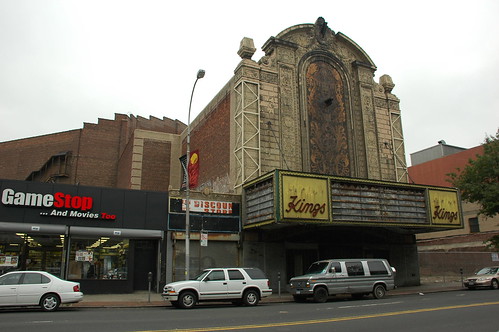
From today’s NY Times City Room:
A developer has signed an agreement, made a down payment on a $70 million renovation of the Kings and plans to turn it back into a functioning entertainment venue, this time presenting live performances, city officials said Tuesday.
– Crumbling Movie Palace Finds an Angel
Loew’s Kings Theatre Exterior Then and Today. Credit: NYC EDC
For some amazing photos of the interior, see marioletto’s Flickr set.
After a four year process -– and many false starts — the city has selected a company based in Houston, ACE Theatrical Group, to renovate and operate the theater. It would be, once again, the biggest indoor theater in Brooklyn and would host 250 concerts, theatrical performances and community events annually, officials said.
Under the terms of the agreement, ACE Theatrical Group will restore the theater to its original French Renaissance-style and expand its stagehouse to accommodate modern shows. Live performances may include theatrical productions, dance and performing arts presentations and musical and comedy shows, as well as community events. The design phase of the project will begin immediately. Construction is expected to begin in two to three years and take approximately two years to complete. According to the EDC, the project will create 530 construction jobs and 50 permanent jobs, not including individual production personnel.
– Loew’s Kings To Be Transformed Into ‘Wonder Theater’ Once Again, Brooklyn Eagle, 2010-02-03
Related Content
Links
Loew’s Kings To Be Transformed Into ‘Wonder Theater’ Once Again, Brooklyn Eagle, 2010-02-03
Crumbling Movie Palace Finds an Angel, NY Times City Room, 2010-02-02
NYCEDC and Brooklyn Borough President Seek Redevelopment of Former Loew’s Kings Theater, NYC EDC Press Release, 2006-09-28
RFP for Restoration of Loew’s Kings Theatre, NYC Economic Development Corporation
Central Park Rabies Outbreak
This month, 23 raccoons in and around Central Park have tested positive for rabies. In addition, 11 animals tested positive during December 2009, bringing the two-month total to 34.
In contrast, from 2003-2008, only one raccoon tested positive in Manhattan. In 2008, only 19 animals tested positive for all of New York City.
This increase may be the result of increased surveillance by the Health Department:
With the identification of three raccoons with rabies in Manhattan’s Central Park in recent months – two during the past week – the Health Department is cautioning New Yorkers to stay away from raccoons, skunks, bats, stray dogs and cats and other wild animals that can carry rabies. The recent cluster of findings suggests that rabies is being transmitted among raccoons in the park. The Health Department is increasing surveillance efforts to determine the extent of the problem.
– Press Release, 2009-12-07
Historically, raccoons are by far the most commonly reported animal, comprising about 3/4 of reports from 1992-2008. Raccoons are nocturnal, and should be active only at night. Anyone observing a raccoon active during the daytime, or any animal that appears disoriented, placid, or aggressive, should call 311 immediately to report the location. Animal attacks should be reported to 911.
Related Content
Rabies reminder from NYC DOH, 2009-07-21
Rabies in NYC: Facts and Figures, 2008-07-08
Meta: Rabies More Popular Than Sex, 2007-03-07
News: Raccoon Tests Positive for Rabies in Manhattan, 2007-02-28
Links
Animals Testing Positive for Rabies in New York City in 2010, year to date
Health Department Cautions New Yorkers to Avoid Wild Animals and Vaccinate Pets against Rabies, NYC DOH Pres Release, 2009-12-07
Rabies, Communicable Diseases, NYC DOH
The End of “Gowanus Lounge”
This morning I discovered that the domain for Gowanus Lounge had been appropriated by a commercial site. I learned this afternoon that the domain had been sold.
Gowanus Lounge had been the project of founder Robert Guskind, who died (too soon) in March of 2009. Archived content from Gowanus Lounge is now available at a new, “memorial” domain, bobguskind.com.
I’ll be updating my links to the old Gowanus Lounge site to the new domain in his name. It saddens me to have to do this, but I must, since Bob’s work is no longer available at the original domain. It’s clear to me that the new proprietor of the domain expects to garner hits through links to Bob’s old work. I refuse to support that.
How to find links
Two Google keywords let you find links from a specific domain to another:
- link:
- finds links to the specified domain
- site:
- limits the search to links from the specified domain
So, to find links from my blog to the old Gowanus Lounge domain, I searched this in Google:
[bit.ly]
Links
Robert “Bob” Guskind Memorial Site
Much Ado About the Gowanus Lounge, That Greenpoint Blog, 2010-01-03
We Are the Champion … Trees!
Via Press Release from the Brooklyn Botanic Garden.
Brooklyn, New York—October 26, 2009—On Tuesday, October 27 at 2:45 p.m., the New York State Department of Environmental Conservation (DEC) will award two trees at Brooklyn Botanic Garden “State Champion” status, affirming that they are the largest of their species on record in the state. The trees, a Kansas hawthorn (Crataegus coccinoides) and a Carolina holly (Ilex ambigua var. monticola) are the first trees in New York City to receive this honor. Only native or naturalized, nonhybrid species are eligible for champion designation. These specimens were nominated by a private citizen and their dimensions verified by the DEC.
At the presentation, which will take place in the shade of one of the champion trees, Brooklyn Botanic Garden president Scot Medbury and DEC regional director Suzanne Mattei will make remarks, and educators from the DEC will lead a group of students from BBG’s affiliated high school, Brooklyn Academy for Science and the Environment, in a workshop on the techniques used to measure big trees.
For more information on the New York State Big Tree Register and champion status, please visit www.dec.ny.gov/animals/5248.html. For more information on big trees at BBG, please visit bbg.org/exp/bigtrees/info/what.html.
NYSDEC RECOGNIZES NEW YORK CITY’S FIRST CHAMPION TREES
Tuesday, October 27, 2009 | 2:45 p.m.
Brooklyn Botanic Garden, 1000 Washington Avenue, Brooklyn
2/3 to Eastern Parkway/Brooklyn Museum or B/Q to Prospect Park
To arrange press credentials for the award ceremony, please contact Kate Blumm, BBG Communications Manager, at 718-623-7241 or kblumm@bbg.org.
Save the Campus Road Garden in Flatbush
Update, 2009-10-09: The Daily News has picked up the story, a few days after it’s been in the Brooklyn Blogosphere.
Campus Road Garden, South Midwood, Flatbush, Brooklyn, August 2008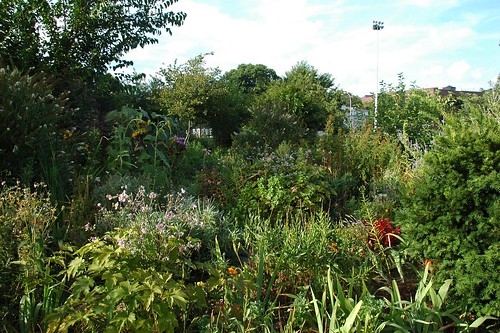
The fate of the Baltic Street Garden in Park Slope was, unfortunately, sealed months ago. And now Flatbush’ 14-year old Campus Road Garden is threatened by Brooklyn College’s plans to build a parking lot in its place.
View Brooklyn Community Gardens in a larger map
The garden has a [long] history and a lot of love, sweat and passion went into creating the garden and sustaining it through the years.
The college has made beautiful new additions to the campus: building, walkways, etc.
However, the garden, which lies at the foot of the athletic field, is going to be bulldozed to make room for a small parking lot.
As you can imagine we are all saddened by this. Each member joined for their own reasons, but the bottom line is, we all come together as a community and we cherish the friendships we have made with fellow gardeners, the Brooklyn College community and, of course, the neighborhood.
– Letter from the author of Snowballs and Candy Corn
Here’s how you can help.
- Sign the online petition: Stop the Demolition of the Campus Road Garden. (You’ll be prompted to contribute through PayPal, but you can ignore that.)
- On Facebook, join the group Stop the Demolition of Campus Road Garden! to stay informed.
[bit.ly]
Related Content
South Midwood Garden Tour and Art Show, 2009-08-18
Other Gardens: South Midwood Garden Tour, 2006-07-30
Links
Stop the Demolition of the Campus Rd Garden, online petition
Snowballs and Candy Corn: Our Garden, a collection of blog posts from one of the Campus Road gardeners, a neighbor and friend
Saving the Campus Road Community Garden from Parking Lot Fate, 2009-10-19
Brooklyn College to pave over popular garden to expand track, Flatbush residents not pleased, Daily News, 2009-10-09
Campus Road Community Garden – Petition, Ditmas Park Blog, 2009-10-05
City Council Approves Demolition of Historic PS 133, Historic Districts Council Newsstand, 2009-07-01
Bring me the head of the Juniper Valley Tree-Killer
Over the weekend, 12 newly planted trees were destroyed at Juniper Valley Park in Queens. This incident marks the fourth case of tree damage this year at the park and a $2,500 reward has been offered for information leading to the arrest and conviction of anyone involved in this arborcide. It is believed that the trees were cut with an electric saw, either late Saturday night or early Sunday morning. They were just planted in the park this past spring. Ten were cherry trees and two were oaks.
– Parks Asks the Community’s Assistance in Nabbing Juniper Valley Park Tree Killer, Press Release, 2009-09-16
Juniper Valley Park has been victim of tree arborcide and vandalism four times this year, with more than 20 trees victimized. In April, low branches were torn off a number of trees overnight. In June, two trees were found damaged in the park and in July, seven trees were damaged, leaving four uprooted, two completely destroyed and one with trunk damage.
If you have any information on this crime, please call the NYPD Crime stoppers hotline at 1-800-577-TIPS.
[bit.ly]
Related Content
Urban Trees and Social Marketing, 2008-04-21
Factoid: Street Trees and Property Values, 2007-12-02
Barbara Corcoran Hates the Earth, 2007-11-18
New York Magazine: How Much Is a Street Tree Really Worth?, 2007-04-09
News: $1,100 to plant a tree in NYC, 2007-03-28
Links
Parks Asks the Community’s Assistance in Nabbing Juniper Valley Park Tree Killer, NYC Parks, Press Release, 2009-09-16
Vandals Attack Trees Again in Juniper Park, Juniper Park Civic Association, 2009-09-13

